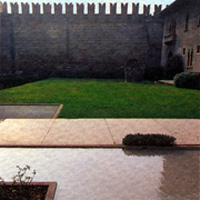
Castelvecchio in Verona
The International Carlo Scarpa Prize for Gardens
XII Annual Award, 2001
The jury of the Carlo Scarpa International Prize for Gardens has unanimously decided to dedicate the twelfth prize to the Castelvecchio in Verona.
It is a place that today appears as a stratification, almost like an audacious collage of different commemorative deposits: made up of parts, moments, materials, different water sculptures, from the broad river that passes under the three arches of its bridge to the small designed artefacts, the heights of invention of our times. Spaces and man-made elements together create a surprising arrangement of towers, courtyards, gardens, museum routes in which rooms and open spaces, horizontal and vertical communicating paths alternate uninterruptedly. Many pieces have been erected, dismantled, erected again, added and taken away by historical events spread over at least two millennia. Despite this, as a whole it provides a unitary historical testimony.
Castelvecchio occupies a crucial position in the form and life of the town. It is situated at the point where the Postumia road – decumano massimo of Roman Verona – hugs the first large bend of the river Adige, while the second loop enclosed the town up until the Free Cities Age. After the Gothic, Lombardic and Frankish dominations, in the first half of the twelfth century the Commune fixed the new limit of the town to the west with a simple, authoritative act, cutting the inhabited peninsula with a wall and a through canal (Adigetto).
After thirty or so years of Ezzelini rule (mid thirteenth century) and after the Della Scala family (in the twenties and thirties of the fourteenth century) had drastically enlarged the forma urbis, moving the defences outwards, it was decided to build a fortified residence in this very place, amidst the confusion of river, canal and Roman road. The Della Scala castle thus took its first completed form (mid fourteenth century) of grandiose deterrent, incorporating ancient and medieval existing forms plus a bridge built within a short time to exit over the river. The castle, which was initially called San Martino in Aquaro after the small church to be found within the outer bailey, therefore acted as fortress and as crossroads for free movement, aditus-exitus, both towards the country and towards the town.
Over the years the castle, the towers, the walls, the baileys, the bridge changed many times, also radically, in their physical layout and end use. It was a Della Scala residence at the beginning (1354-1387); a Visconti and then a Carraresi fortress in the next twenty years (1387-1402, 1402-1405); a Venetian military stronghold for almost four centuries, arsenal (1405-1796), and then also military engineering academy (from 1762); Napoleonic barracks for about twenty years (1796-1814), also when the Austrians took up positions on the other side of the river (from 1801); Austrian barracks for over half a century (1814-1866); Italian barracks for over half a century (1866-1925). In 1923 Castelvecchio was handed over by the Military State Property Office to the Municipality of Verona, which continued to house the officers’ club there and in 1925 created a museum recalling medieval times in the wing of the outer bailey towards the river. At the end of the fifties a radical transformation of the museum commenced and is still in progress.
Text taken from the 2001 Carlo Scarpa Prize Statement, edited by the Jury.
